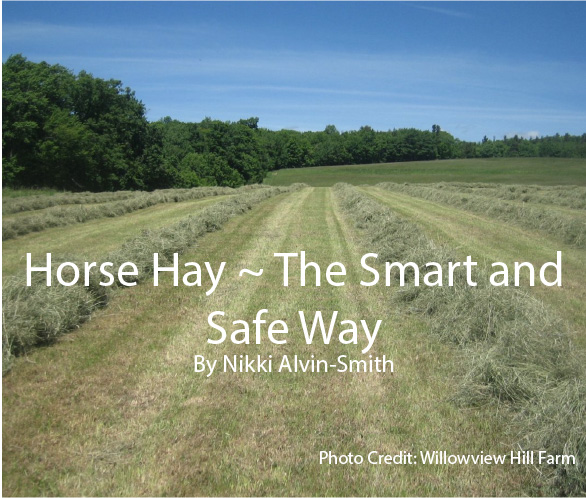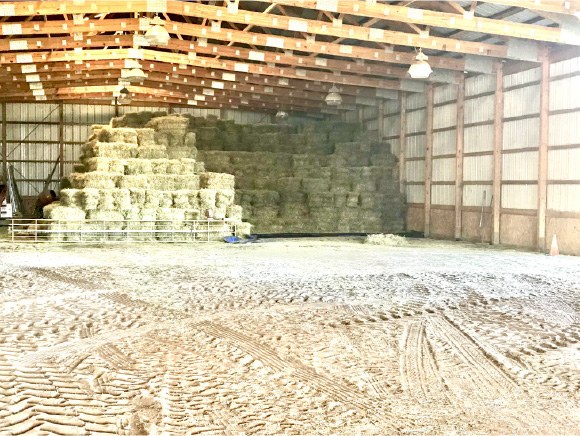Horse Hay ~ The Smart and Safe Way
By Nikki Alvin-Smith

Horses love hay and it’s our job to ensure that the hay we provide for them is clean, green, nutritious and safe for them to eat. As with any other product, it is false economy to buy poor quality hay. Not only can inferior hay be detrimental to the health of your horse, even to the point of causing death from colic or poisoning, it can also cause less obvious health issues such a mild respiratory inflammation.
If you purchase good quality hay then it is also important that you ensure you keep it that way. Poor storage practices can present a fire hazard or cause the hay to mold or dust. So here’s a few tips to help you choose the best hay and to store it properly.
Moisture Matters
Hay can be cured the old fashioned way by Mother Nature’s rays of sunshine and heat, or by using dry-down agents, adding chemical preservatives or drying hay on large racks with hot air. The aim is the same, keeping the moisture content low so that the hay will cure properly and not dust or mold.
On our farm in the Catskill Mountains of Upstate New York we cure our organically grown hay using just Mother Nature’s help and we don’t use any chemicals or preservatives. Some times she is more helpful than others! In any event we cure it to less than 14% moisture content to ensure that the hay presents no fire hazard when stacked and stored.
As a horse breeder for more than 25 years, I prefer to avoid using any additives that my horses will have no choice but to ingest that have not been tested as safe to use. There are over 20 different chemical additives that are routinely added by dairy farmers and large hay producers to hay, to speed up the drying time. Unfortunately most (if not all), have not been tested for equine safety in proper clinical trials. So if this concerns you check the provenance of your hay and ask questions of the hay producer. There have been concerns raised in the medical community that certain hay additives can cause at a minimum, upper respiratory inflammation especially in young horses.
How do you know the moisture content of the hay you wish to purchase? For approximately $125 you can purchase a hay wand from any tractor dealer or online, which you can use to indicate the moisture content of any bale from a sensor in the end of the wand.
Clean and Green
The term clean hay refers to hay that is free of nefarious weeds. While there are many equine herbal delights that are deliberately sown into hayfield grass mixes, there are other weeds that are toxic to horses especially if eaten in large quantities. Source your hay from farmers that have professionally seeded their fields specifically for hay production.
From a nutritional aspect, ‘green as a dollar bill’ hay is generally going to have more benefit to the equine diet than a dried yellow colored product. However, hay may sometimes suffer a rain shower and lose some of its inherent green color. While this may decrease the presence of certain minerals or vitamins such as Vitamin A, it does not necessarily mean the hay still doesn’t have some useful nutritional benefit for the horse. The best way to measure the various components of nutritional value in the hay you select is to have it tested. A core sample can be pulled from any bale and presented for testing to your local agricultural Extension Office. The results are of key importance in provision of the knowledge you need to ensure your horse enjoys a balanced diet.
The choice between 1st cut, 2nd cut or even 3rd cut hay, should be determined by the breed, age, medical requirements and performance level of your horse. 1st cut hay will have more seed heads and variety of grasses in general. This variety keeps your horse busy chewing and occupies him better than 2nd cut. The latter is generally higher in nitrogen and richer which may not suit older horses or smaller horse breeds. It is best to consult with your veterinarian if you are unsure as to what your horse needs.
Hay should also be free from dead animals or vermin. Horses can die from botulism if they ingest contaminated fodder so be aware of this possible issue especially if you use large round bales where their presence may be less obvious.
Hay Storage
It is important that your hay storage area provides good ventilation and is free from any dampness or water.
If you have old hay left on the floor of your storage area from the year before be certain to sweep or vacuum it out. Old hay that has sat will be dusty and may contaminate the new crop. Always repair any holes in the roof prior to storing hay.
The base of the stack should always be protected from any rising damp that comes from a dirt floor or concrete floor. You can use a tarp to cover the ground and add a layer of pallets if you have any available.
From the moisture and safety standpoint, it is best to stack with the strings on the bales on the vertical side of the stack. This will allow any remaining moisture in the bales to drain through to the floor.
When you stack the hay always run each layer in the opposite direction to the one beneath to create a stable stack. Leave a small gap between each bale to allow for air circulation.

Your hay storage space will hopefully be well ventilated through a cupola or ridge vent system. If you store hay in a metal container you can expect the hay quality will quickly deteriorate due to condensation of moisture during temperature changes.
Don’t Play With Fire
If you ever suspect your hay is building heat in the center of the stack due to too much moisture in the product and that spontaneous combustion is likely, do not be tempted to pull the bales out to check it out yourself. Call your Fire Department immediately. If you disturb the stack, the sudden infusion of oxygen may cause the hay to ignite.
Safe Feeding Methods
We’ve all seen the videos posted online of horses standing in the middle of metal feeders, haltered horses dragging feeders around by their heads when their halters have become hooked on the feeder and all the serious injuries that can occur when the wrong type of feeder is used for large round bales.
Cow feeders are too low to be safely used for horses. Always use feeders that are specifically designed for horses and be certain to remove string from the bales and never leave halters on horses turned out with feeders in the field.
About the author: Nikki Alvin-Smith is an international Grand Prix dressage trainer/clinician who has competed in Europe at the Grand Prix level earning scores of over 72%. Together with her husband Paul, who is also a Grand Prix rider, they operate a private horse breeding/training farm in Stamford, NY.


